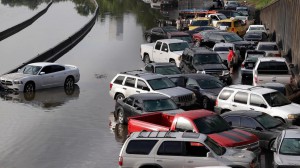
The storms that battered much of middle America resulting in floods means the used car market may see some of these water-damaged vehicles for sale.
The storms that have swept across the middle of the U.S. in recent weeks have caused extensive damage and a number of deaths. But there could be plenty of new victims in the weeks and months ahead.
Perhaps 10,000 vehicles were seriously damaged or totaled in Texas alone, according to industry experts. And they worry that many of those could wind up back on the U.S. car market, their titles “washed” so that unsuspecting buyers don’t realize the risks they face.
Flood-damaged vehicles can undergo cosmetic repairs that often mask, rather than resolve, longer-term issues, such as rust, mold and mechanical problems that could plague buyers later on, experts warn.
“A car that’s been in a flood, with the engine submerged for any length of time, will never be the same,” Carl Sullivan, a veteran inspector for California-based AiM, told TheDetroitBureau.com.
The actual number of vehicles impacted by the flood is likely to be significantly higher than formally reported because many older models might not have relevant insurance coverage, notes the National Insurance Crime Bureau.
Legally, any vehicle damaged or declared totaled due to flooding should have that clearly marked on their titles. Most of them will either be scrapped and recycled or they may be broken down for parts.
“Unfortunately, some of the flooded vehicles may be purchased at bargain prices, cleaned up, and then taken out of state where the VIN (the unique Vehicle Identification Number) is switched and the car is retitled with no indication it has been damaged,” noted the NICB in a warning statement.
Appropriately, the process is known as “title washing.”
(Ferrari’s spin off delayed again. For more, Click Here.)
Meanwhile, individuals with flood-damaged cars with no insurance coverage may simply repair the vehicles and put them on the market without disclosing that information.
CarFax, a service that helps used car buyers validate title information and a vehicle’s history, estimates that a large number of damaged vehicles routinely go back on the market. Of the 75,000 cars, trucks and crossovers affected by 1999’s Hurricane Floyd, for example, CarFax estimated half were eventually resold.
That’s not necessarily illegal, as long as buyers are told of the damage.
(Click Here for details about a possible new full-size SUV from Hyundai.)
While a flood-damaged vehicle might undergo extensive repairs, experts stress that long-term issues could emerge. They point to rust in areas where water might have pooled. Electrical circuits, such as head and taillights are more prone to shorting out. And mold can develop in hidden places.
Experts warn that today’s vehicles are particularly prone to long-term issues due to the extensive use of microcomputer systems for everything from engine controls to safety devices.
(To see more about NHTSA’s prototype vehicle to keep drunk drivers off the road, Click Here.)
They offer several tips for cautious shoppers:
- Newly replaced upholstery or trunk liners may hint at flood repairs;
- Look for rust in places normally not prone to damage, such as upper door hinges and trunk latches;
- Rust or mud under the gas and brake pedals;
- Beads of water in places like a vehicle’s dome light;
- A musty or moldy smell.
Buyers should also make sure the VIN number on the dash matches the one on the vehicle’s driver door jamb.

No doubt many consumers will get defrauded on these vehicles because the States and Feds constantly fail at their responsibility to protect consumers.